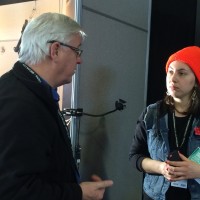On Monday, the annual Celluloid Ceiling report was published. Researchers from San Diego State University found that out of the 250 top grossing films last year only 5% had a female cinematographer. That’s only a 1% increase on 1998, when they first did the study!
Where are all the female DPs?
The female cinematographer is a rare sight on big films. In 2016, only 7% of the top 500 films featured a female DP. The bigger the budget the worse the picture! Just 3% of the top 100 blockbusters had a woman behind the lens. The British Society of Cinematographers (BSC) has 4 female members out of a total of 277. In the US, the ASC counts just 11 women among a membership of 339. It’s not surprising therefore that no female cinematographer has been nominated for a BAFTA in the history of the awards.
Female pioneers in Hollywood and beyond
But if you look behind the headlines a different scene is emerging. Polly Morgan is one of those three female BSC members. Last year, Polly also featured in Variety Magazine’s ’10 Cinematographers to Watch ‘ and polish DP Monika Lenczewksa joined her on the list. So Variety chose 20% women – a much cheerier statistic!
NFTS graduate, Charlotte Bruus Christensen represented 1/6 of the DPs featured on a recent Hollywood Reporter roundtable! Also there was BAFTA nominated DP Bradford Young, one of the very few black cinematographers to be recognised at this level. Charlotte has more than earned her place in this company. Last year she shot both the commercial hit ‘The Girl on the Train’ and the critically acclaimed ‘Fences’ .
The myth of the ‘female’ film project
Charlotte’s choices challenge the myth that women steer clear of bigger budget productions. It’s true that many more female cinematographers work on documentaries, tv drama or independent films, but does that mean they’re actively avoiding the big projects?
illuminatrix is a collective started to raise the profile of female cinematographers and co-founder Catherine Goldschmidt disputes this:
‘I’m sure more women DPs would love to do bigger budget projects. I look at someone like Mandy Walker ASC ACS, who went from shooting a $30million film to a $130million film. She is such a trailblazer in this regard. The job is the same after all, just with more resources to work with. Speaking for myself, I am absolutely ready and willing to take on a larger responsibility. I’m sure this is true for so many of us. We have the talent and the ambition, we just need the opportunity to prove ourselves!’
More women directors= more female DPs
The Celluloid Ceiling report also reveals that a female director is much more likely to appoint a female cinematographer. 16% of female directors on the films surveyed made that choice. And, there’s no doubt that women are starting to break through in the wider industry. Last year, both the BAFTA for British short film and the award for Best British Animation went to female teams of NFTS graduates. Organisations like Women in Film and Television are working across the industry to share these kind of successes. Their mentoring scheme is just one way they give newcomers access to what is a stereotypically close-knit industry.
Celluloid sisters – give that girl a hand
Here at Greenkit, we’re delighted to sponsor the cinematography award at the Underwire Festival each November. That means we get a sneak peak at the fantastic female cinematographer talent working on short films. An unscientific survey of our regular client list reveals that 20% are female cinematographers or gaffers. So, if you see a great film shot by a female cinematographer, share it. And, if you are a female cinematographer and you need great kit; you know where we are.
(Photos of Polly Morgan and Catherine Goldschmidt are courtesy of our friends at illuminatrix)




